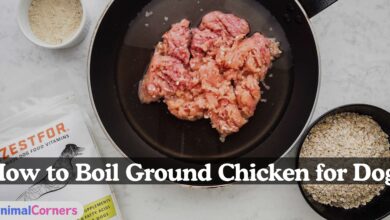How Much Homemade Dog Food Should I Feed My Dog

Maintaining your dog’s health and happiness depends on feeding it the proper amount of food. Homemade dog food has several advantages over some commercial options, including higher nutrition and control over the ingredients. Homemade meals can be customized for dogs with allergies or sensitivities to fit their unique nutritional requirements.
But to reap these benefits, you must know how much homemade dog food is appropriate for your dog. Enough food keeps them healthy and energized while also assisting in maintaining their desired weight. Therefore, the secret to ensuring your dog gets the most out of their prepared meals is knowing how much is appropriate.
In this guide, we will learn “How Much Homemade Dog Food Should I Feed My Dog“
What Factors Influence How Much Food My Dog Needs?
Feeding your dog the right portion of homemade food depends on several key factors.
Factors Influencing Food Quantity
1. Dog’s Age
Age has a significant impact on how much food is consumed. Compared to adult or older dogs, puppies need more calories and nutrients since they are growing. While adult dogs need well-balanced meals to maintain their weight, younger puppies require more energy to support their rapid growth. On the other hand, older dogs might require fewer calories to prevent needless weight gain.
2. Dog’s Weight and Size
Another crucial consideration is your dog’s size. Smaller breeds typically require less food due to their smaller stomachs and slower metabolisms than larger breeds. On the other hand, large breeds need more food to meet their energy needs because of their larger bodies.
3. Activity Level
The amount of food a dog needs is greatly influenced by its degree of activity. Compared to very active dogs, sedentary dogs who spend most of their time indoors require fewer calories. Exercise-loving dogs, such as those who run or play agility sports, need extra calories to support their active lifestyle.
4. Health Conditions
The amount of food a dog requires depends on several medical issues. While dogs with allergies may require specially prepared foods, obese dogs may need fewer calories to aid in weight loss. If a dog has particular health concerns, it’s critical to customize its meals because this might enhance its general well-being.
What is the 80-10-10 rule for raw dog food?
🐶 What is the 80-10-10 Rule? | The 80-10-10 rule is a guideline for making raw dog food. It says that your dog’s meal should contain 80% meat, 10% bone, and 10% organs. This balance gives your dog all the nutrients it needs to stay healthy. |
🥩 80% Meat | Most of your dog’s food (80%) should come from muscle meat. This can include things like chicken, beef, lamb, or turkey. Muscle meat gives your dog protein and other nutrients that help them grow and stay strong. |
🦴 10% Bone | Bones make up 10% of the raw diet. These provide calcium, which is important for strong bones and teeth. Be sure to use raw, soft bones like chicken wings or necks, which are safe for your dog to eat. |
🧠 10% Organs | The last 10% should come from organs like liver, kidney, or heart. Organs are packed with vitamins and minerals, especially Vitamin A, which is good for their eyes and immune system. |
⚖️ Why is the 80-10-10 Rule Important? | This rule ensures your dog gets a balanced diet. Too much or too little of one part could make them sick, so it’s important to stick to this ratio. A balanced diet leads to a happy and healthy dog! |
🚨 Things to Watch Out For | Avoid feeding cooked bones because they can splinter and harm your dog. Also, introduce new foods slowly to prevent upset stomachs. Always use fresh, high-quality ingredients. |
Calculating Food Portions
Understanding “How Much Homemade Dog Food Should I Feed My Dog” can be daunting. But you can make this process easier by considering a few important steps. These steps will help you ensure your pet gets the proper nutrition without overfeeding or underfeeding them.
Consult with a Veterinarian
A veterinarian is your best friend when determining how much food your dog requires. These professionals can provide guidance based on your dog’s age, size, health, and activity level because they have a thorough understanding of dogs’ nutritional needs. Consulting a veterinarian when creating a feeding plan for your dog will help ensure that it remains healthy and energetic.
Use of Online Calculators and Tools
In the current digital era, you can use simple internet calculators to determine how much food your dog requires. Usually, these calculators ask you for your dog’s weight, age, and degree of exercise. Based on this information, they then estimate how many calories your dog should eat each day. Although these resources offer a solid foundation, they cannot replace expert veterinary guidance.
Common Formulas
You can also utilize a few general rules and formulas to determine portion proportions. A popular approach is to consider your dog’s weight and exercise level. A reasonably active dog, for example, may require roughly 30 calories per pound of body weight each day. Although individual needs can vary, this fundamental formula offers a general sense of how much to feed. Constantly adjust according to your dog’s traits and watch how they react to their food.
How Can I Adjust My Dog’s Portion Sizes?
Maintaining your dog’s health requires adjusting the portion sizes of their food. It’s essential to monitor your dog’s weight and general health and be prepared to change their diet.
Monitoring Your Dog’s Weight and Health
Check your dog’s weight frequently to ensure its diet is appropriate. To determine whether your dog is gaining or losing weight, weigh it every two weeks or once a month. If you observe any significant weight changes, consider changing the amount of food they eat.
Signs That Your Dog Might Need More or Less Food
There are a few clear indicators that your dog may need to adjust its food sizes. If your dog appears more lethargic or unmotivated than normal, it may require additional food. However, if it appears tired and has put on weight, you may need to cut back on its meals.
Changes in Weight, Energy Levels, and Coat Condition
Although your dog’s weight and activity level are good markers of its health, the state of its coat is equally crucial. If your dog has a glossy, healthy coat, it is likely receiving the proper calaories. If its skin seems dry or its coat turns lifeless, it might be time to change its nutrition. Be alert always; for individualized guidance, think about speaking with a veterinarian.
See Also :- Can Dogs Use Inflatable Swimming Pools
Tips for Homemade Dog Food Preparation
Ingredient Selection
Picking the right ingredients is crucial when making homemade dog food. Dogs need fresh, high-quality ingredients free from harmful chemicals and additives.
Using human-grade meat, fresh vegetables, and whole grains ensures your dog gets a balanced meal. For example, lean meats like chicken or beef provide essential proteins, while carrots and peas offer necessary vitamins and minerals.
Remember, including various ingredients helps cover all nutritional bases for your pet.
Recipe Ideas
Starting with simple recipes can make preparing homemade meals easier. A basic recipe might include cooked chicken, brown rice, and steamed vegetables like carrots and green beans.
Mix these ingredients to provide a balanced diet rich in protein and essential nutrients. Another idea is a beef stew that includes ground beef, sweet potatoes, and peas.
Just be sure to avoid foods toxic to dogs, such as onions or chocolate.
Cooking and Storage
Proper cooking and storage play a vital role in ensuring the safety of your dog’s meals. Always cook meat thoroughly to kill harmful bacteria, and avoid raw meat unless guided by a vet.
Once the food is prepared, store it in airtight containers in the refrigerator to maintain freshness. Homemade food can typically be refrigerated for 3-5 days.
Consider freezing portions for longer storage. Label each container with the preparation date to keep track of freshness and ensure your dog always eats safe, healthy meals.
Final Remarks
In conclusion, providing your dog with homemade food can be a rewarding experience, enhancing their health and happiness while allowing for greater control over their diet. It’s important to remember that each dog is unique, and their dietary needs can vary greatly. Therefore, tailoring their meals to their specific requirements ensures optimal health and longevity. As you embark on this journey, don’t hesitate to consult with veterinarians or pet nutritionists for professional guidance.
As Dra renowned veterinary nutritionist Dr Sarah Thompson wisely puts it, “The best diet for your dog is one crafted with love, expertise, and a little bit of science.”
Common Queries About Homemade Dog Food Feed
How do I know if my dog is getting enough nutrients?
Ensuring your dog receives all the necessary nutrients is crucial for their well-being. One way to monitor this is by observing your dog’s energy levels, coat condition, and overall health. A balanced diet should result in a shiny coat, average weight, and high energy levels. If you have concerns, it’s always best to consult a veterinarian for your dog’s needs.
How much raw food should a dog eat a day?
A dog typically needs to eat about 2-3% of its body weight in raw food each day. For example, if your dog weighs 50 pounds, they might need 1 to 1.5 pounds of raw food daily. Always start with small portions and adjust based on your dog’s needs.
What is the best raw food ratio for dogs?
A typical raw food ratio is 80% muscle meat, 10% raw edible bone, and 10% organ meat. This balance provides a mix of nutrients that helps keep your dog healthy and strong.
Should I feed my dog raw food once or twice a day?
Feeding your dog raw food once or twice a day is fine. Some owners prefer feeding twice to split the meals into smaller portions. Choose what works best for your dog’s routine and watch how they respond.




